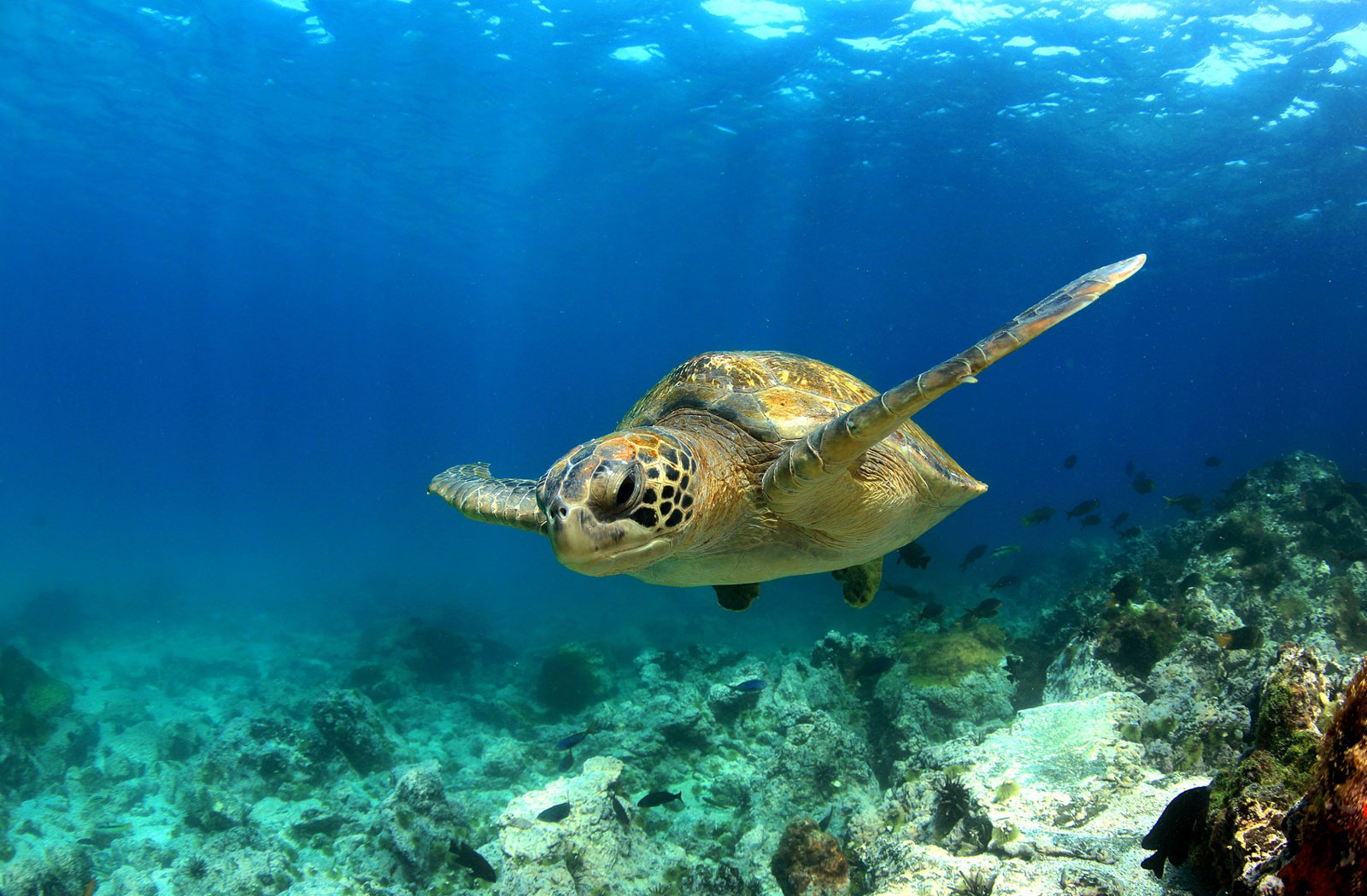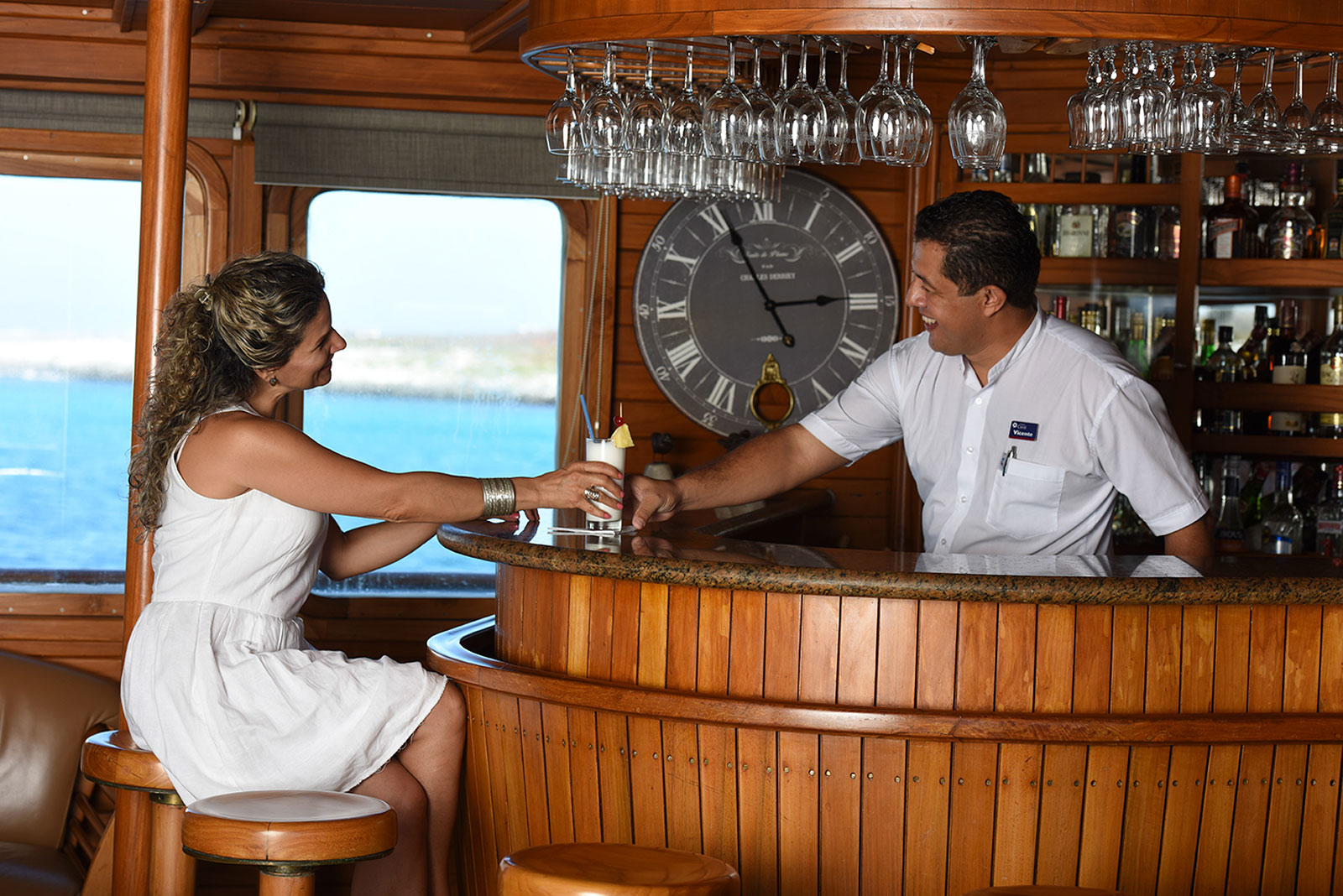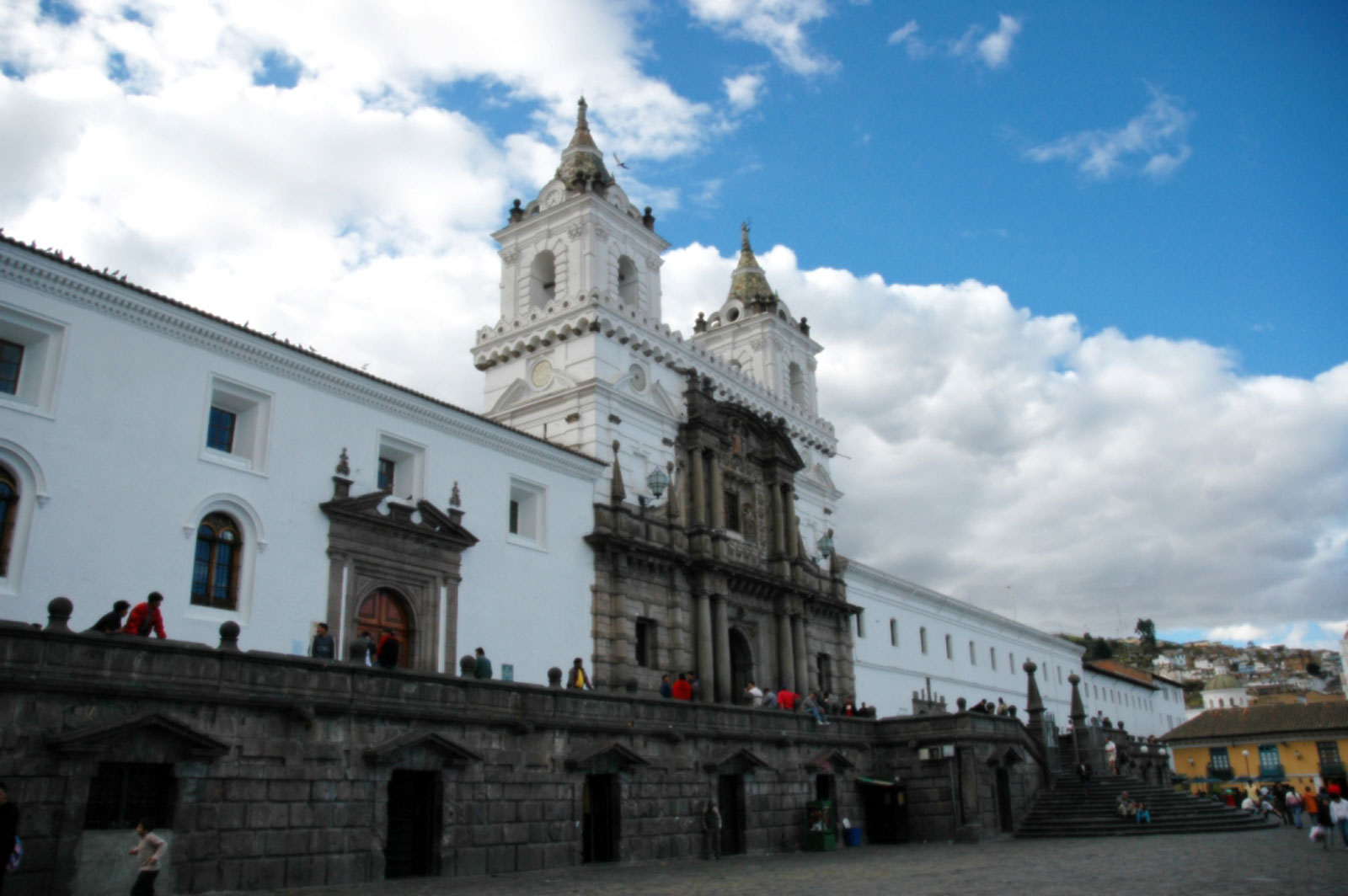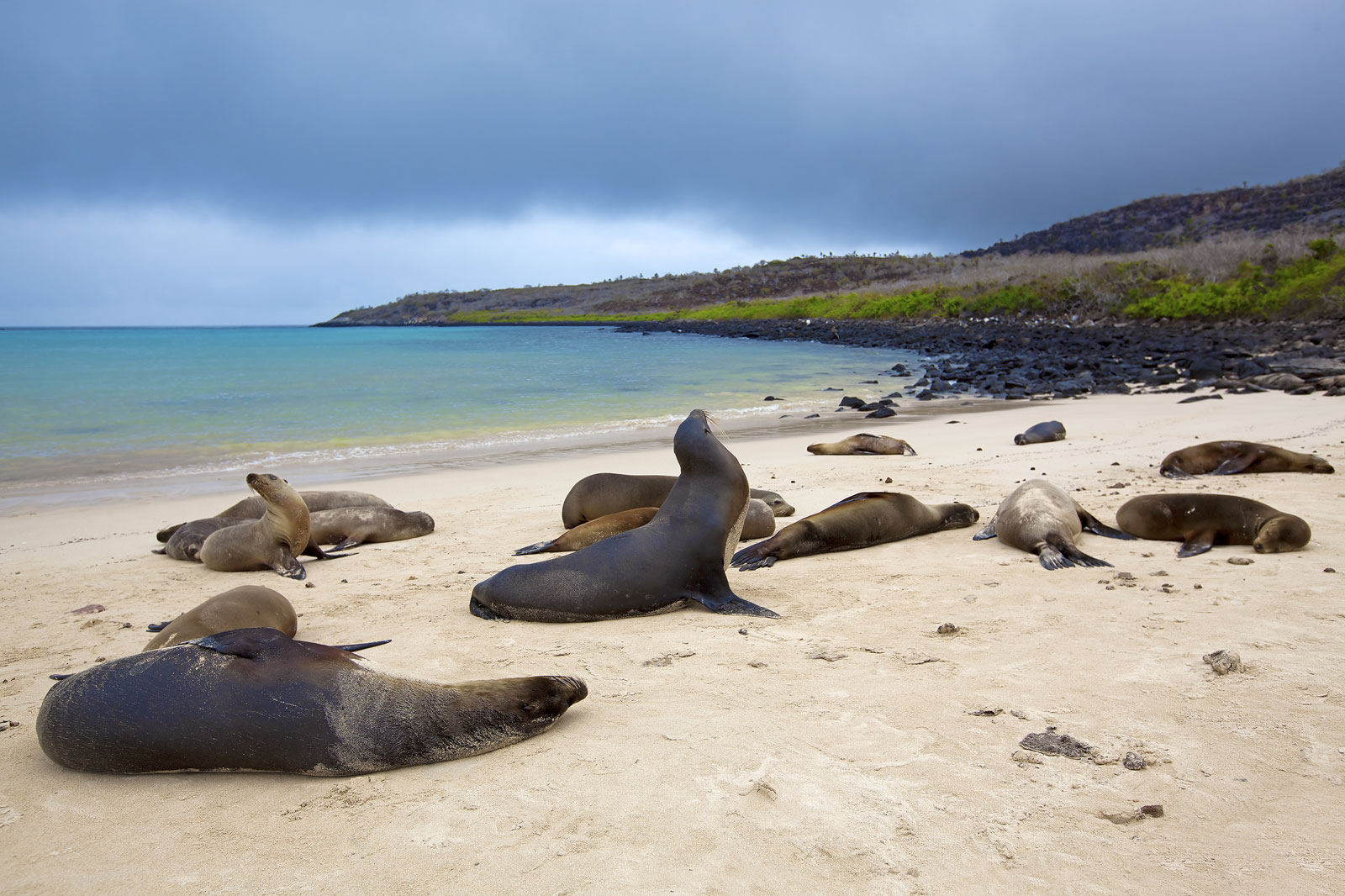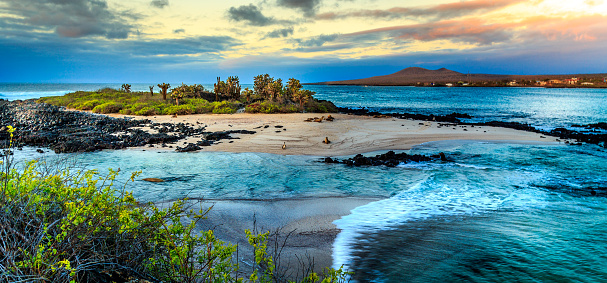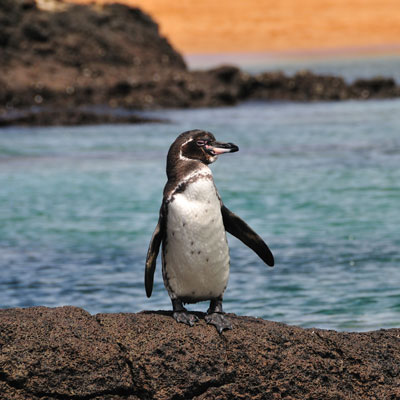 For a cultural and wildlife adventure, journey to the Galápagos Which came to be known as the Enchanted Isles by their first visitors because they seemed to appear magically, often enveloped in fog. Begin with three nights on the mainland discovering UNESCO World Heritage marvels in Quito, snow-capped mountains and fantastic shopping in Otavalo, and friendly people every step of the way.
For a cultural and wildlife adventure, journey to the Galápagos Which came to be known as the Enchanted Isles by their first visitors because they seemed to appear magically, often enveloped in fog. Begin with three nights on the mainland discovering UNESCO World Heritage marvels in Quito, snow-capped mountains and fantastic shopping in Otavalo, and friendly people every step of the way.
Then board your vessel for a four-night cruise aboard the Coral I or II, to experience close encounters with animals found nowhere else on Earth. Feel the wind in your hair as you motor in an open panga between the boat and the next island, where your hikes will be accompanied by knowledgeable guides eager to share their knowledge and enthusiasm for this world treasure.

Ecuador & The Galapagos Islands pricing:
Ecuador & The Galapagos Islands
Natural Selection in the Enchanted Isles
Date of trip:
October 27th to November 4th, 2019
Price of trip:
Main program: $5,495 per person
Optional post-trip extension to Peru and Machu Picchu
Post-trip: $4,395 per person
Travel Dates
Depart San Francisco on your way to Ecuador, via Miamia. Upon arrival to Quito in the evening, you will be escorted to your elegant hotel, which is located in the heart of historic “Quito Antigo” and surrounded by churches, museums and national monuments.
An official National Treasure, Patio Andaluz holds centuries of history within its walls and is a marvelous building of Colonial origin, which offers every visitor an experience not unlike turning back in time. It was part of the original Solaris (original building sites) that constituted the City of San Francisco of Quito at the time it was founded. Enjoy the enchantment and comfort that this elegant boutique hotel offers, with large arches, balconies and towering attics that give the feeling of being in the republican era. The inviting guestrooms have hardwood floors, vaulted ceilings, original works of art, and fresh picked flowers and feature colonial style headboards, armoires, Latin work desks with antique lamps, color televisions, and large windows looking into the courtyard. Hotel amenities include a coffee shop, full gourmet restaurant, a Tapas wine bar, spa, gym, and solarium. Overnight at the HOTEL PATIO ANDALUZ. www.hotelpatioandaluz.com
Your half-day tour today will show you what Quito displays: the largest colonial town of the Americas and the first UNESCO World Heritage Site. Enjoy the eclectic architecture ranging from the modern quarters to varied colonial facades on churches, private residences and decorated balconies built within the last five centuries. The tour includes parks like El Ejido and Alameda, the monument of Simon Bolivar, the gothic Basilica of the Heart of Jesús, Independence Square developed during the past five centuries and flanked by the Presidential and the Archbishop’s palaces dated back to XVII and XIX centuries, and the Metropolitan Cathedral with excellent samples of the Spanish renaissance.
Walk along the so-called Street of the Seven Crosses and pass by the Jesuit convent, once headquarters of the first university in the country, El Sagrario church with a unique orthodox cross layout dated back to the 17th century, and the jewel of the crown, the Jesuit temple of La Compañía de Jesús, perhaps the most important monument of the baroque art in Quito. From there continue to the plaza of San Francisco, with temple and convent known to be the largest of the once Spanish colonies on the Americas which displays a rich sample of artistic and cultural heritage. Enjoy an afternoon at leisure to explore on your own. At night, you will enjoy a welcome dinner at Theatrum. Overnight at the HOTEL PATIO ANDALUZ. (B,D)
Early this morning you will depart for South America’s most famous Indian fair, the Otavalo Market, centered around ‘Poncho Plaza’. Drive across the colorful valleys of Guayllabamba and Cayambe. Guayllabamba is rich in fertile soil and through effective irrigation systems has become an important producer of avocado and the local cherimoya fruit. Cayambe, traditionally dedicated to dairy cattle and manufacturing of dairy products, has recently enjoyed an important boom in rose farming. The breathtaking setting offers great photo opportunities and after two hours of traveling through the riveting Andean countryside, you will arrive at the province of Imbabura, known as the Ecuadorian Land of Lakes.
The Otavalo Craft Market is the most famous and picturesque in South America. While the main market is on Saturday’s, there’s always a mini market going on, no matter what day of the week one visits. Markets are meeting places for shopping, bargaining and chatter, while people of the region exchange local produce, animals, utensils, pots and pans or textiles. For visitors, the markets offer the possibility of approaching Ecuadorians at a more intimate level as you negotiate prices of a variety of woven goods, bags, hats, flutes or simply appreciate the skillful and generous people responsible for the elegance and beauty of the clothing and handicrafts. After a busy shopping day, there is nothing better than a delicious lunch at one of the local haciendas.
On your way back to Quito, time permitting, visit Cotacachi, an Indian village which features leatherwork including bags, jackets, hats, gloves and belts, Cuicocha Crater Lake, whose wonderful scenery is dominated by mountains and moorland scenes with numerous native plants and many birds or visit the village of Peguche with traditional looms and handcrafted wind instruments where you can purchase their goods directly from the people who make them. Overnight at the HOTEL PATIO ANDALUZ. (B,L)
This morning, transfer to the airport for your flight to Baltra. Upon arrival on the island, you will be met by your naturalist guide and taken for a short bus ride to the pier to board the vessel, the M/Y Coral I or II. On land and in the sea, the Galapagos Islands give the impression of a diabolic Garden of Eden. The islands’ tumultuous volcanic history of scorched earth and fiery flows are evident the moment you arrive. Inhospitable. Uninhabitable. Tortured. These are the adjectives inspired by the lava-seascape. But look closer… this seemingly Spartan landscape is in fact teeming with life – the first of the Galapagos’ many contradictions. Suddenly you realize that what you thought was a rock is in fact a sun-seeking iguana! And to add to your surprise, it doesn’t seem the least bit perturbed by your intrusive gaze… another Galapagos contradiction. Due to their long history of isolation from humans, both land and sea animals remain virtually fearless and unaffected by visitors. This is the land that Charles Darwin visited as a naturalist on board the HMS Beagle, which was bound on a long scientific survey expedition to South America and the South Seas (1831-36). His zoological and geological discoveries on the voyage resulted in numerous important publications and formed the basis of his theories on evolution.
For the next five days, you will bear witness to our planet’s most captivating wildlife; for example, the Island’s namesake, the 600-pound tortoises, which in the Spanish language, are called Galapagos. You’ll be mesmerized by the awe-inspiring landscapes and misty volcanic peaks. The underwater world is equally enchanting. This afternoon after the welcome briefing and safety drill, a delicious buffet lunch is served. Afterwards, drop anchor and travel by bus to Cerro Chato Reserve, one of the best places in the archipelago to see giant tortoises in their natural habitat. The tortoises are easy to spot, lumbering around, eating grass and leaves and wallowing in the small pools that are common in the reserve. You may also spot some highland birds, like Cattle Egrets, mockingbirds, finches or flycatchers. There are several lava tunnels in the reserve, a great place to spot the Barn Owl. There is also a small lagoon covered in red algae where gallinules and Galápagos Pintails can be found. Overnight aboard the M/V CORAL I OR II. (B,L,D)
Since there is no landing site at this location, the coastal exploration is by panga, where your naturalist-guides will commit to explaining the dramatic geology of the area with remains of lava flows and tuff stone layers. This is the nesting place for Flightless Cormorants, the only existing marine birds in the world other than penguins that have changed their condition of flying birds to diving birds. Wildlife also includes sea lions, Galápagos fur seals, Galápagos Penguins, Blue-footed and Nazca Boobies and Noddy Terns. This area has a very rich marine life and is seasonally visited by green sea turtles. Depending on the conditions of the ocean, you can enjoy a snorkeling outing along the cliffs of partly-sunken Ecuador Volcano, in the northern tip of Isabela Island, (Punta Vicente Roca).
In the afternoon, you disembark at Punta Espinosa, Fernandina. Located in the western part of the archipelago, Fernandina is the youngest and most pristine island found in the Galapagos. Hundreds of marine iguanas, the largest colony in Galapagos, bask in the sun along the rugged shoreline. Observe sea lion harems with resident bulls carefully guarding their territory. Flightless Cormorants build their nest on the point and Galapagos Hawks fly overhead. Evidence of recent lava flows formed by an active volcano stretch their way around the coast. Overnight aboard the M/V CORAL I OR II. (B,L,D)
This morning, disembark at Urbina Bay (wet landing), located at the foot of volcanoes Alcedo and Darwin, western Isabela Island, the result of an uplifting of the ocean in 1954. Here you can find corals, shells and many other calcareous organisms exposed above water. This area is also home to large and very colorful Galápagos land iguanas, giant tortoises (occasionally); a good spot to observe Darwin’s finches. Along the shoreline, after the hike you may encounter Flightless Cormorants and see Galapagos Penguins while snorkeling in this beautiful cove. Return to the ship for lunch.
After lunch disembark (dry landing) at Tagus Cove on Isabela Island, where 19th and 20th century ships’ graffiti can be seen on the towering cliffs. After hiking beyond Darwin Lake, a saltwater lagoon above sea level, you will be rewarded with extraordinary views of Darwin and Wolf volcanoes. Six volcanoes flowed together and formed Isabela, the largest Island in the Galapagos. Enjoy a panga ride through the mangrove area to see the rays, turtles, sea lions, and, circling overhead, Galapagos Hawks. Possibilities to swim or snorkel will be present. There is no beach in the area, so these activities are done from the pangas. Overnight aboard the M/V CORAL I OR II. (B,L,D)
Wet landing on a beach of black volcanic sand, visited by Darwin in 1835. In 1683, William Ambrose Cowley visited this place, and it was he who gave the English name of James to the Bay and the Island. British buccaneers anchored in this whole area during the 1600s, as it was a good place to find meat like giant tortoises to eat, as well as fresh water to drink. Stroll along the shoreline at Puerto Egas, Santiago looking for octopus, starfish and other sea life caught in the small pools as the tide goes out. You may also see the Great Blue Heron, Lava Heron, Oystercatchers and a Yellow-crowned Night Heron. If the tide is low, you’ll see marine iguanas grazing on the exposed green algae. Your walk comes to an end when you arrive at the fur seal grottos; these are the deep pools of clear water where you can swim with the shy fur seals that hide in cool caves. This will be your best opportunity to see the fur seal, once thought to be on the verge of extinction.
After lunch, board the panga for the short ride to the landing site at Sullivan Bay on the east coast of Santiago. Wet landing on a white coral sand beach, and then walk over lava that flowed here less than 100 years ago. This is the perfect place to see and feel the volcanic origin of Galápagos. The last major eruption on Santiago was probably in the early 1900’s. One observer aboard a sailing vessel reported that the ship approached the lava flow so closely that the pine tar used to seal the hull of the ship began to soften, and the captain had to hurry the ship away from the bay. As usual, you will have your briefing and dinner after you are back on the ship. Overnight aboard the M/V CORAL I OR II. (B,L,D)
Your final stop before you depart is a visit to Bachas Beaches. These two small beaches are found to the West of Turtle Cove. Their sand is made of decomposed coral, which makes it white and soft, a favorite nesting site for sea turtles. Behind one of the beaches there is a small brackish water lagoon, where it is occasionally possible to observe flamingos and other coastal birds, such as Black-necked Stilts and whimbrels. The other beach is longer and has two old barges that were abandoned during the Second World War, when the USA used Baltra Island as a strategic point to protect the Panama Channel. (The metal is rusty and sharp, so it is not a good place for swimming.) Afterwards, transfer to the airport for your flight back to Guayaquil. Upon arrival, you will be escorted to your elegant hotel ORO VERDE, where a dayroom is reserved for you. Enjoy the rest of your day at leisure. Later this evening you will be transferred to the airport for your return flights home. (B,D)
This morning finds you in the USA with incredible memories of spectacular wildlife and incredible people. Whenever you look back on this experience just know that you’re in good company – the Galapagos Islands have touched the hearts and imaginations of Lord Byron, Charles Darwin and countless others like yourself.

Daniel Costa is a distinguished professor of ecology and evolutionary biology at UC Santa Cruz.
His research focuses on the ecology and physiology of marine mammals and seabirds, taking him to every continent and almost every habitat from the Galápagos to Antarctica. He has worked with a broad range of animals, including turtles, penguins, albatrosses, seals, sea lions, sirenians, whales, and dolphins and has published over 400 scientific papers.
His current work is aimed at recording the movement and distribution patterns of marine mammals and seabirds in an effort to understand their habitat needs. In addition, his research is studying the response of marine mammals to underwater sounds and developing ways to assess whether the potential disturbance may result in a population consequence. He cofounded the Tagging of Pacific Predators program, a multidisciplinary effort to study the movement patterns of 23 species of marine vertebrate predators in the North Pacific Ocean. He is an internationally recognized authority on tracking marine mammals and birds.


